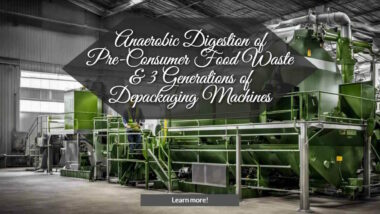Food waste biogas, in other words, making renewable fuel (methane) from local authority food waste (by using it as a feed for the Anaerobic digestion (AD) process) to make biogas is a marvel. But it has numerous potential pitfalls.
It can ONLY be an effective component of a municipal organics recycling system if done right, and there are many pitfalls making it easy to fall into the trap of unintentional greenwashing.
Read on for guidance on how to navigate the complexities of anaerobic digestion because it is a Green Marvel but a complex subject fraught with pitfalls.
Food Waste Biogas: Key Takeaway
Food waste biogas produced by Anaerobic Digestion (AD) process stands as a beacon of sustainability in municipal waste management. However, its potential isn't without pitfalls. By adhering to a set of best practices, municipalities can navigate these challenges, optimizing AD's ecological contributions while mitigating risks.
[boomdevs_toc]
Introduction
The global shift towards sustainability has steered innovations like Anaerobic Digestion (AD) to the forefront of waste management strategies. In the municipal landscape, where organic waste is becoming more abundant through the rising nationwide implementation of kerbside household food waste “caddy” collections, AD's allure is its promise of green energy and soil enrichment.
However, beneath this eco-friendly veneer are pitfalls that, if overlooked, can undermine the very essence of sustainability it promises.
Herein lies the importance of a comprehensive best practice guide for communities intending to harness the power of AD without falling victim to its complexities. Read on for our first attempt at such a guide:
Understanding AD – The Process Behind Making Food Waste Biogas
AD is a biological process occurring in oxygen-free environments. Organic materials, including municipal wastes such as food scraps and even lawn mowings, are metabolized by microorganisms, producing principally:
- biogas (a renewable energy source) and
- digestate, a nutrient-rich substance beneficial to soil health.
Unlike conventional organic waste disposal methods (including composting) that emit considerable greenhouse gases, AD captures the energy within organic waste, leveraging it to foster a circular economy.
However, AD isn't a one-size-fits-all solution. Its effectiveness and sustainability hinge on meticulous planning, an understanding of organic waste complexities, and a commitment to principles that prioritize the long-term health of the environment.
Best Practices for Optimizing Food Waste Biogas Production
1. Adherence to National and International Waste Management Hierarchy Rules (Including the EPA Food Recovery Hierarchy)
Before diving into AD to produce food waste biogas, municipalities must embrace a foundational waste management philosophy: the locally applicable “hierarchy” which gives priority to alternative disposal routes for food waste. An example which applies to the US is the EPA Food Recovery Hierarchy.
Applying hierarchical rules ensures waste prevention and reduction are given first preference in that order, asserting that the most sustainable waste is that which is never created!
By integrating practices like surplus food redistribution, municipalities ensure that AD serves its purpose without becoming a crutch that perpetuates waste generation.
2. Prioritizing Soil Health
AD's magic extends beyond biogas to the digestate, a treasure trove of nutrients for soil replenishment. However, this requires the digestate to undergo further processing like a final stage of composting of the fibre content, ensuring its safe return to the soil:
- enhancing fertility,
- water retention, and
- carbon sequestration.
Municipalities must adopt a soil-first approach, recognizing the provision of this form of renewable fertiliser as a secondary benefit of AD. For example, the drying and incineration of the fibre for additional energy should be considered as a poor second to applying better attention to the removal of plastics and metal fragments from the digester feed.
There is no excuse now for sending digestate to a landfill due to it not meeting quality criteria (e. g. degree of absence of trace metals, sharps, and microplastic). Innovative 3rd generation depackaging equipment is available to provide high-purity clean organic pulp which after the digester will be suitable for land spreading on crops.
3. Acknowledge the Role of Strategic Waste Stream Management
Not all organic waste is best used for food waste biogas use. Biscuit and bakery waste for example should be segregated and sent to specialist recycling facilities to make animal feed.
Hence, discerning the ecological and economic implications of treating various waste types is crucial. Some materials might find their highest utility through other forms of recycling or composting, especially if AD doesn’t conserve their nutrient profiles.
4. Integrating AD within Comprehensive Organic Waste Strategies
AD/ food waste biogas should not be considered in isolation. An effective organics recycling program involves an intricate balance of strategies, including commercial composting and localized efforts.
Yard waste, food-soiled paper, and certain bioplastics (starch-based film bags etc), for instance, may resist biodegradation in anaerobic or composting environments. These should be diverted to appropriate facilities, ensuring that what emerges from AD plants is a boon, not a burden, to the soil and ecological health.
5. Scaling and Technological Alignment
The over-development of AD facility capacity in any locality can be counterproductive, disincentivizing waste reduction efforts. Technologies and process provisions in each locality must align with the community's specific organic waste challenges, accommodating fluctuations and evolving needs. This dynamic approach avoids the pitfalls of over-reliance on a single solution.
6. Contamination Reduction
Quality input determines quality output.
The AD process is compromised if the organic waste is contaminated with non-digestible and non-compostable materials.
Rigorous source separation protocols, public education, and policy support are essential to maintaining the integrity of the inputs and, by extension, the outputs of AD.
7. Environmental Safeguards
AD plants must be bastions of environmental protection, not just through their outputs but their operations. Implementing best-available control technologies and practices minimizes the environmental footprints, particularly concerning emissions to air and water.
Food Waste Biogas Conclusion
AD is an extraordinary tool with its ability to create large quantities of food waste biogas in the quest for sustainability, but its efficiency and green benefits are not inherent.
They are marvellously beneficial outcomes to be reaped from careful planning, adherence to best practices, and an unwavering commitment to ecological, efficiency in the use of raw materials, and all other “circular economy” principles.
When orchestrated effectively, food waste biogas production using the AD process harmonizes with other waste management strategies, contributing to a resilient, sustainable, and healthful environmental legacy.
Local authorities venturing into this realm must tread thoughtfully, bolstered by knowledge and guided by the principles of holistic environmental stewardship.
Frequently Asked Questions
What is Food Waste Biogas?
It is the biogas (methane) made when food waste is processed through the Anaerobic Digestion process where microorganisms break down organic materials, like food waste and lawn mowings, in an oxygen-free environment. Biogas is a renewable energy source, and digestate is also a by-product, which can enrich soil health.
Why is AD considered environmentally friendly?
AD transforms waste into valuable resources, reducing the environmental impact of organic waste disposal. It helps in the production of green energy, decreases greenhouse gas emissions, and contributes to soil fertility through the production of nutrient-rich digestate.
What are the potential pitfalls of AD?
Despite its benefits, AD can have drawbacks if not properly managed. These include over-reliance on technology, the potential for contamination, mismanagement of outputs, environmental harm due to improper emissions control, and inefficient use of resources if the system is not integrated with broader waste management strategies.
How can the effectiveness of AD be maximized?
To ensure AD's effectiveness, municipalities should adhere to best practices like applying the Waste Management Hierarchy which demands prioritizing waste reduction, enhancing source separation, ensuring proper digestate utilization, integrating AD into a comprehensive waste strategy, and implementing environmental safeguards.
Is AD suitable for all types of organic waste?
No, certain materials like woody waste, food-soiled paper, and some bioplastics may not fully decompose during AD. These materials may need to be diverted to other processing systems like composting to ensure complete breakdown and utility.
Can AD handle fluctuating amounts of waste?
Ideally, yes, but it requires careful planning. Facilities should be designed to accommodate variations in waste quantities without compromising operational efficiency. This flexibility avoids over-dependence on AD and encourages continued emphasis on food waste reduction initiatives.
What role does public education play in the success of Food Waste Biogas production via AD?
Public education is crucial. By informing communities about proper waste segregation, the importance of waste reduction, and the benefits of AD, municipalities can enhance source separation, reduce contamination, and garner support for sustainable waste management practices.
How does AD contribute to soil health?
AD produces digestate, a by-product rich in nutrients. When processed further, typically through composting, this material becomes a valuable soil amendment, enhancing soil fertility, moisture retention, and overall health, promoting a cycle of sustainability.
Does AD support local community development?
Yes, when integrated into broader waste management and sustainability goals, AD can contribute to local economies. It can generate employment, offer educational opportunities, and provide community investment potential through the production of renewable energy and soil amendments.






